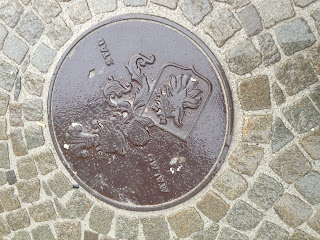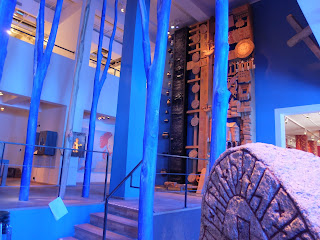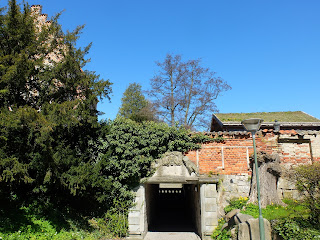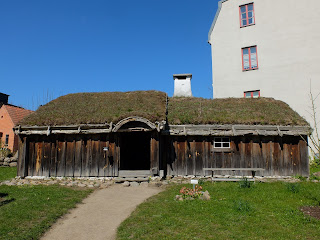When all the shock of whiteand taffy, the world’s baubles and trinkets, leavethe pavement strewn with the confetti of aftermath,the leaves come. Patient, plodding, a green skingrowing over whatever winter did to us, a returnto the strange idea of continuous living despitethe mess of us, the hurt, the empty.
-- "Instructions on Not Giving Up", Ada Limón
I totally forgot that May Day holiday would mean no school on a Monday until my coworkers reminded me on the second to last week of April. The thought of spending the long weekend laying around watching movies did not appeal (sort of my default state during this past spring semester, mostly because it took me about a month to completely kick the never-ending upper respiratory bug I brought with me to Hungary from Kosovo and then just because I could).
I looked around and found an absurdly cheap round flight from the nearby city of Debrecen to Malmö, Sweden for the approaching holiday. It was impulsive but part of the beauty of teaching in the public school system in Hungary is the freedom to do impulsive, last-minute trips like this. I found a reasonably affordable single room AirBnb in what looked like the house of a nice family and decided to go for it. I woke up Friday morning and headed to school to teach my four classes only to find the last two were cancelled due to school-wide festivities so I headed for the airport. Thank God for that cancellation because by the time I'd caught a bus to the Debrecen bus station and a taxi to the airport I had basically just enough time to check in and get through security before my flight was boarding. The flight was peaceful and relatively short and soon we landed in Malmö, which is located in southern Sweden's region of Skåne. I took the picture above when were passing over what I'm pretty sure was the island of Bornholm. As always with budget airlines, after arriving I jumped on the shuttle and settled in with the bus's WiFi for the 45 minutes ride to central Malmö.
I walked around, lost, for probably about an hour and a half before I got myself oriented enough to find my AirBnB (less than stellar directions on her end and a lack of street signs worked against me) but I did get to take in some sights while wondering around hopelessly.
Swedes play American football?
A surprising but welcome sight! Burek... in Sweden? I didn't end up eating here but I did strongly consider it. Instead, after settling in I walked back to the city center (my apartment was about a 45 minute walk away) and took myself to the movies. I saw Guardians of the Galaxy 2 and dined on the finest theater chain popcorn and candy that money could buy. It was glorious and I was surprised to learn that in Sweden (or at least this theater) right before the movie begins, one of the ushers stands in front of the audience makes a speech. I didn't understand a word of it obviously but based on context clues I think it was the usual: shut off your cellphones, stop talking, the exits are under the impossible-to-miss glowing red signs that say "exit", etc. After he finished he got a thunderous round of applause from the audience so I guess he did his job to the satisfaction of everyone involved? Let's leave that there.
The next morning I was up and out but at an hour that was not particularly bright nor early. I woke to the sound of a downpour happening outside and happily hibernated in my little closet bedroom for a few hours until the skies lightened. My goal was to be in the city center in time for the free walking tour at one thirty. But first I intended to check out Folkets Park (the People's Park), a free public space with a ton of oddball attractions for kids but still some sort of interesting adults for us adults.
Love a good manhole cover!
But first, obviously I stopped to take a picture of a sign with the word "infart" on it. Obviously.
It's a habit of mine to snap a shot of Tin Tin whenever I see it in the window of a book store because my dad is such a fan.
Finally! The Folkets Park.
This creepy/melancholy statue is apparently Göte Forsberg, a famous professional Swedish clown.
The rose fountain (foreground) and the Moorish Pavilion (background).
Finally at the center of town and not being able to settle on any of the amazing-looking food trucks in Folkets Park, I was unable to resist the siren call of burritos for lunch.
Making my way to the meeting point I passed this whimsical set of marching band statues, titled "The Optimistic Orchestra".
The tour met and began in Stortorget, a 16th century square that is well known for its architecture and statue of King Karl X Gustav (pictured above).
Next we moved on to Lilla Torg, the smaller, adjacent square famous for its once-bustling market place (now it's mostly VERY expensive cafes, restaurants, and handicraft-style souvenir shops).
Original tiles in the cobblestones denoting where vendors were to set up their stalls.
This fountain was the drinking water for the much smaller town of Malmö. As you can see by the other tour-goers, at this point in the tour it started once again pouring and we definitely lost a few of those who were not fully committed to learning all about the wonders of Malmö.
This had some significance.
I believe it had to with one of the Sweden's more infamous kings.
Flower market vendors, not giving up despite the weather!
Next we entered the King's Park (Kungsparken) and walked through the Old Cemetery (Gamla kyrkogården), which is interesting because it's located inside the park and is very neatly arranged by family plots.
Walking along the river towards The Castle Park (Slottsparken).
The Japanese rock garden, still in Slottsträdgården, near the windmill.
The Castle Mill! (Slottsmöllan)
A rare selfie to demonstrate the clothing type required for the weather in Malmö on that Saturday. When I left Hungary, I was completely comfortable in jeans, boots, and a t-shirt. I was at this point enjoying my visit but also wondering why I chose to go north in early spring when the last thing I was need was more cold or rain.
The ducks army plots its inevitable hostile takeover.
Then, we were approaching the Malmö Castle (Malmöhus), a 15th century fortress surrounded by a still-filled moat.
WWII-era Swedish ambulance.
Inside the castle courtyard, there's a map of the original walled city of Malmö. The castle houses a city museum which I did not get a chance to visit but which does sound interesting.
Next we headed towards the train station, passing the World Maritime University and this giant, metallic ship rudder.
Finally, our walk ended at the beautiful, Gothic 14th century Saint Peter Church (Sankt Petri kyrka). Overall this tour was really great and I would recommend it to anyone looking for something to do in Malmö. The tour guide was funny and knowledgeable and threw in a bunch of fun facts about Swedish history and language along with an abundance of local information.
(Same church, photo taken in better weather the next day)
After some R&R back at the apartment, I headed back out into the night to catch the sunset and check out a local craft brewery I'd read about, Malmö Brewing Company.
Victory! I found it. And it was in this building that used to Richter's Brewery, which apparently dates back to 1898. From what I can find online it appears that the new owners opened in 2013 but decided to leave the original signage up outside.
I had one of their stouts from on draft and a pulled pork sandwich that was excellent. Even though I really, really hate eating out by myself (even with a book or my phone I still end up feeling so awkward and lonely) this was worth the social anxiety.
The next day, Sunday, the weather was actually beautiful, cold but clear, which was good news because my plan was to take the train to Lund to see Kulturen, Sweden's second old open-air museum. It was the day before May Day, which the Swedes celebrate as Walpurgis Night (Valborg) with a pagan-like celebration of huge bonfires, dancing, and singing. Actually the whole day is a holiday as well, known as "siste april". According to Wikipedia:
"The strongest and most traditional spring festivities are also found in the old university cities, such as Uppsala and Lund, where undergraduates, graduates, and alumni gather at events that last most of the day from early morning to late night on April 30, or siste april ("The Last Day of April") as it is called in Lund, or sista april as it is called in Uppsala. For students, Walpurgis Eve heralds freedom. Traditionally the exams were over and only the odd lecture remained before term ends. On the last day of April, the students don their characteristic white caps and sing songs of welcome to spring, to the budding greenery and to a brighter future."
I didn't stick around Lund in the evening for the festivities but I did see a lot of people arriving in the town ready to celebrate with barbecue gear, chairs, alcohol and white hats.
Some national pride spotted on the way to the train station.
Aand the train station.
Train breakfast (of champions).
Interested statue located in front of the Lund Cathedral.
The Lund Cathedral, which is probably most famous for the astrological clock inside. It's not entirely clear when it was built or if it's the original church in Lund. It seems like it was sometime in the 11th century.
The astrological clock was added in 1380 and the two knight figures come out at when the clock chimes, on the hour every hour.
A less famous but still beautiful clock in the church.
Bibles of all languages available for people to choose from.
Having seen the clock do its hourly performance, it was on to the main event, Kulturen! I had really been looking forward to seeing this place after doing my last-minute research on Skåne after I had bought plane tickets, so the nice weather and siste april concurrence (resulting in the museum being almost empty) all pointed to this visit being serendipity. Most of the rest of this blog post is going to be dedicated to the (for me) fascinating contents on the museum so if that is not of interest to you, check out here!
Kulturen Map
Kulturen is a museum that was founded in 1892 by a local historian who realized that the traditional lifestyle of southern Swedish farmers was disappearing and wanted to find a way to preserve it as historical artifact. He was also in the right place at the right time because he was not only able to add local buildings to the museum but medieval artifacts that were discovered as the town of Lund excavated to build a sewage system. One of the big goals of the original houses and then with the buildings added later to the open-air section of the museum is to show how life was in the four "estates" of society (nobles, clergy, burghers and peasants). So.
- White House. Inside the first building are a ton of different rooms full of stuff from medieval and earlier life in Lund, including bone fragments, clothing, jewelry, tools, artwork/handicrafts and more.
"The First Inhabitant of Lund... The oldest known grave in Lund was excavated in 1974. There is not much left of the oldest inhabitant of Lund but the bone fragments imply that he was a man in his seventies when he died.... dating of the grave to 990."
I would gladly wear, like, almost any of these.
Just some skulls. Apparently they are the heads of those whose at an attempt to start a revolution/civil war in Denmark for independence failed. Very badly.
A bad-ass tile-covered stove from around 1560. Sidenote: my country did not even exist yet. Cool cool cool.
Horns/skulls of cattle, which apparently was often imported from other places around Lund. And the horns were saved for posterity, I guess.
How early Swedes did not lose all their toes with these quaint little moccasins is a mystery. There was a ton of more interesting stuff, by the way, but I was burning daylight and really wanted to get to see some of the other buildings so I carried on.
- Hylla Smithy. Exactly what it sounds like.
This boat had a card with some information that was, unfortunately, all in Swedish. The title was "Blekingseka" and I believe it was saying this boat is from 1899.
Some light horror for your afternoon visit to the local ethnographic museum! And really, if a museum does not have at least one mannequin that makes you slightly regret your life choices that led you to staring into its cold, dead, eyes.... does it even count as a museum? Seriously. No, seriously. Like, for real though. For really real. Sometimes with horses too.
What is this, a cottage built for ants?
The exit! I want that door.
Next was a stuga from Gard, a region of eastern Skåne. Also from the 18th century.
The bed is just, like, in the living room. This is a recurring theme with 18/19th century working class housing in Sweden. Cool. Cool cool cool.
This hanging is great.
An actual private bedroom, hallelujah.
Living room, kitchen, study.
So apparently when the museum expanded from its original piece of land (I'm not sure if it was the south or north end) there was a road bisecting the land acquired and because it was/is a much-used road in Lund the museum built an underpass to connect the two sides of the museum.
- Locus Peccatorum. Unfortunately it was closed when I visited the museum but I Google Translated this highly entertaining explanation for the origins and purpose of the building from the Kulturen website:
I would put this in my house, no joke.
- The Phone Booth. Like from inside it. That was fun.
Mid-19th century living room of the bourgeoisie.
This one was a little bit earlier, I think it dated back to the early 18th century.
There were a few more but for brevity' sake I'll just stick in this exhibit; this was the earliest era of home decorating displayed, dating back to or recreating furnishings from the 16th century.
- Playground.
From the back.
I do enjoy that they set up a little fake "fika" inside, which is a Swedish custom my walking tour guide had told us about the day before and whose custom I made full observance of during my weekend in Sweden. From Wikipedia:
"Fika is considered a social institution in Sweden; it means having a break, most often a coffee break, with one's colleagues, friends, date or family. The word fika can be used as both verb and a noun. You can fika at work by taking a "coffee break", fika with someone like a "coffee date", or just drink a cup of coffee, tea or other non-alcoholic beverage. As such, the word has quite ambiguous connotations, but almost always includes something to eat, such as biscuits, cakes and even sweets, accompanied with the drink. This practice of taking a break, often with a cinnamon roll, biscuits, or cookies, and perhaps with fruit on the side, is central to Swedish life."
Who doesn't love a good 17th century church organ.
Museum cat.
So that's it. Afterwards I wandered around Lund for a bit then headed back in to Malmö. I still had quite a bit of afternoon daylight so I decided to visit the other brewery I had read about, Brewdog. It was fantastic and the food was decent bar food too. Looking at the website it seems like it's an extension of the same brewery found in the UK, interesting. Might explains why there were so many damn lads there when I visited.
Obviously as soon as I saw they had a stout named "Jet Black Heart" I knew I had to try it, which was a good choice because it was maybe one of the best stouts/beers I've ever had.
I fucked up on pouring this "Electric India" which was also a delight and a necessarily lighter quaff than the stout since by that point I was feeling a bit of a buzz.
I wandered around Malmö a bit more, taking in some of the Valborg festivities (although without documenting them very well due to a camera battery death) before crashing pretty early. The next morning, after sharing some delicious arepas, good coffee, and bad Spanish (mine) with my Venezuelan AirBnb host I headed to the train/bus station to take in one last bit of coastal Sweden before I headed back to land-locked Hungary and the rest of my semester.























































































































No comments:
Post a Comment